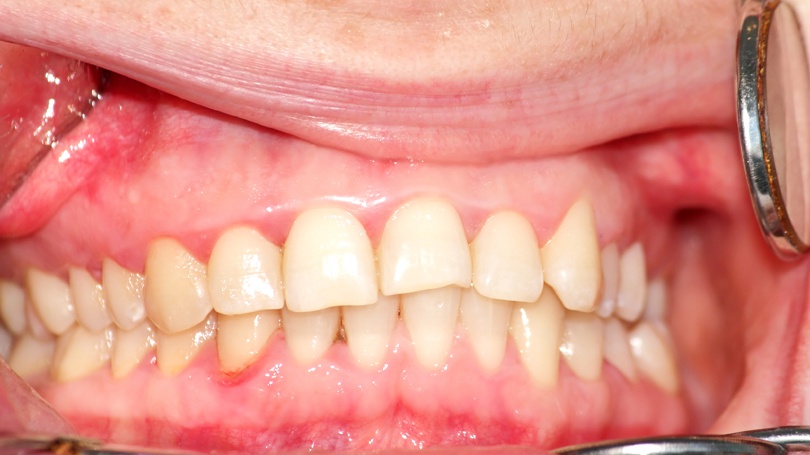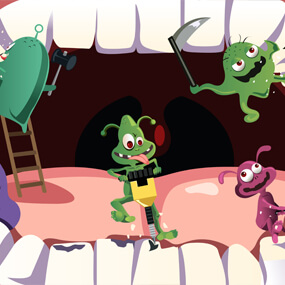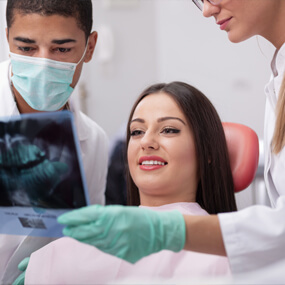Bad Bite: How Malocclusion Can Shape Your Face

Your jawline and teeth are core features that define your face. People will notice an asymmetrical face just as they will be drawn to a symmetrical and thus attractive appearance. You may not have much control over the features you are born with, but malocclusion—an improper bite—and poor jaw alignment, whether congenital or acquired, are examples of qualities where you do have options and which, left uncorrected, can alter your facial contour in a negative way.
A normal bite—where all the teeth are in place and straight and buffering the upper and lower jaw—and a symmetrical jawline lend themselves to a more attractive face. On the contrary, serious alignment issues can distort the facial shape and undermine the symmetry we humans tend to find so appealing. If the top and bottom teeth are mismatched, a face can be concave or protruding rather than be smoothed and defined by the underlying bone structure, such as your cheekbones. On a positive note, however, alignment issues with the teeth, bite, and jaw can be corrected.
What Is Malocclusion?
Bite describes the way your upper and lower teeth come together and rest naturally, which is determined by your jaw. In a normal bite, the upper teeth rest slightly over the lower teeth, and the molars, including their points and grooves, match up. Malocclusion is the technical term for a bad or improper bite, such as a crossbite, overbite, or underbite. It means that the teeth or even the jaw itself are misaligned, which can lead to crooked teeth, tooth wear, and protrusions. Malocclusion can make good oral hygiene more difficult to achieve. It can also cause discomfort and interfere with chewing and speech, and it can alter the characteristics of your face and, thus, your appearance.
A crossbite is when your upper front teeth rest within rather than outside the lower teeth. An overbite describes a situation wherein your front teeth overlap your lower teeth by a significant amount, and an underbite is similar except that the lower teeth overlap the upper. A vertical gap between the upper and lower teeth is known as an open bite, which can make it difficult to close the lips. Often, such examples of malocclusion are corrected in childhood. But if they are not or manifest later in life, then they can cause a wide range of oral health problems and appearance issues throughout adulthood.
How Does Malocclusion Occur?
Malocclusion is often not preventable and simply a congenital defect. It is often an inherited trait, and it is quite common for children to have a small degree of malocclusion. Common issues include too many or too few teeth, too much or too little spacing, an irregular jaw shape or size, and atypical formations, such as a cleft palate. Acquired malocclusion can occur due to bad habits, such as thumb sucking, premature loss of the primary teeth due to an accident or disease, and medical conditions, such as enlarged tonsils.
Can an Improper Bite Cause Health Problems?
A bad bite will generally place undue pressure on the jaw. This stress will affect the temporomandibular joint—where the upper and lower jaw meets—and cause pain not only in the jaw but in the face, neck, shoulders, and back, in addition to causing headaches and perhaps even migraines. TMJ disorders can trigger bruxism, which can damage tooth enamel and lead to tooth decay.
Severe malocclusion can cause problems with speech, such as lisping, biting, chewing, and even breathing. Overbites, in particular, are known to narrow the airway and thus degrade sleep quality. Bad bites can cause snoring and xerostomia—dry mouth—and even upset your equilibrium.
How Does Malocclusion Influence Facial Aesthetics?
- Misaligned bites tend to prematurely age your appearance.
- An underbite makes the jaw more prominent.
- An overbite weakens the jawline and causes sunken cheeks.
- An open bite lengthens the face.
- A deep overbite leads to a face that is short and round.
- Unevenness of a bite disrupts overall shape and symmetry.
How Do You Tell If You Have a Bad Bite?
If the malocclusion is severe, the improper bite may be obvious. But for many people with a bad bite, it is not so clear. The best way to determine if you have an oral health issue is to see your dentist, and if you have problems with speech or any of the other symptoms discussed here, then you should broach those issues with your dentist during the visit. Even if your malocclusion is subtle, your dentist will identify it.
Your dentist has tools to detect an improper bite. He or she can also gauge the consequences. Many people have malocclusion so minor that it is irrelevant to their health. If treatment is required, however, digital imaging can be used to assess the problem and plan the treatment.
Overcoming Malocclusion With Clear Aligners
Historically, dentists have corrected malocclusion with metal braces, but that is not the only or even the best option any longer. Dental medicine has developed clear aligner trays that are comfortable and convenient to wear and which will nudge your teeth into their optimal positions over time. Clear aligners can correct a wide range of bite issues, including overbites and underbites, but it will be necessary to have your individual bite assessed to determine if it is the appropriate treatment for you.
Whether you are a candidate for clear aligners will depend on the severity of the malocclusion. Aligners are quite effective for minor to moderate cases. If the misalignment is severe, however, then traditional braces will be recommended because aligners cannot address the molars the way braces can.
SureSmile and Invisalign clear aligners in Scottsdale are the two premier clear aligner products available. These are transparent orthodontic devices that are placed over the teeth to correct misalignments over time. After an oral examination, your dentist will recommend treatment. In the case of aligners, this is generally followed by a consultation to explain the process and what you should expect moving forward.
If you choose to go ahead with the treatment, your dentist will take digital scans of your teeth. Sophisticated software will then analyze the scans to determine how to move the teeth into their optimal positions, and a byproduct of this process is an animation that shows you the teeth straightening. Using a highly advanced fabrication unit, your aligners will be custom-fabricated to you based on your teeth and the correction required. Clear aligners fit snug. Most people acclimate to them within a couple of days and do not even notice the slight pressure being applied to the teeth. Each aligner is worn for one to three weeks before moving onto the next, and every six to eight weeks, you will visit your dentist to ensure that the treatment process is unfolding as expected.
The Advantages of Clear Aligners Over Traditional Braces
In the event clear aligners are suitable for fixing your malocclusion, this treatment offers many benefits over conventional metal braces with wires and brackets. For starters, there are no brackets and wires. The aligners are also clear and practically imperceptible, which means no one will notice. You can also remove them to enjoy your favorite foods or to brush before bedtime, and this is a game changer because it eliminates a lot of the inconveniences that come with having to wear braces. Another advantage is comfort. You will barely notice them, and they will never cut your inside lip or cheek.
The Benefits of Correcting Malocclusion
If your bad bite is severe enough to warrant correction, then there are many reasons why moving forward is worthwhile to you in the short term and over the long run.
Aesthetic benefits include:
- Younger appearance
- Improved self-esteem
- Enhanced facial profile
Lifestyle advantages involve:
- Positive body image
- Clearer speech
- Proper chewing
- Easier oral hygiene
Benefits to your oral health include:
- Ideal jaw position
- Enhanced gum health
- Healthy tooth structure
- Improved tooth function
- Supporting healthy TMJ function
- Reduced or eliminated TMJ pain
- Supporting proper tongue and lip function
Preventative advantages involve:
- Being less prone to lip biting
- Reduced risk of food impaction
- Avoiding tooth wear and dental damage
- Reduced risk of tooth decay and gum disease
- Eliminating triggers for headaches and muscle pain
Bolster Your Self-Esteem and Appearance
Would you like a more attractive smile and have perhaps been thinking about clear aligners? Scottsdale Cosmetic Dentistry Excellence encourages you to schedule a consultation. Everyone should benefit from a beautiful smile, and premier cosmetic dentist Jeffrey D. Clark, DDS, wants to help you achieve it. Whether you have crowded teeth, an overbite, or some other form of malocclusion, Dr. Clark will help you determine if clear aligners or other treatment options are ideal for you. Call us today at 480 585 1853 to learn more about SureSmile and Invisalign and to schedule your initial consultation.




